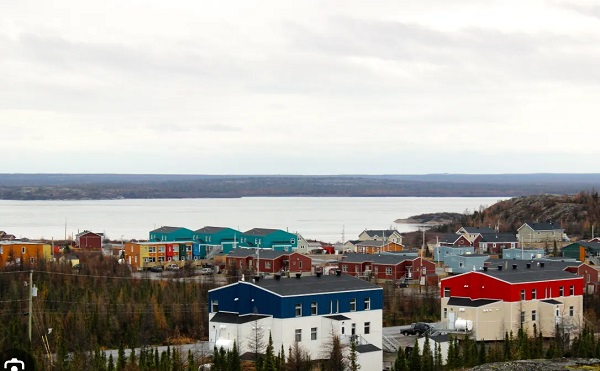Alberta
Energy East May be the Nation Building Mega-Project Canada Needs Right Now

From EnergyNow.Ca
By Jim Warren
Is it Time to Put Politics Aside for Team Canada? – Jim Warren
People on the prairies who understand the value of a flourishing oil and gas sector are hopeful the election of a Conservative government will sweep away the barriers that blocked the Northern Gateway and Energy East pipelines. Some optimistic industry analysts suggest a project similar to Northern Gateway may be doable but concede that reviving Energy East would probably be a bridge too far.
It is getting difficult to recount exactly how many times Quebec’s demands for special treatment have disrupted national unity. Quebec’s rejection of Energy East was the most recent assault on national cohesion to anger large numbers of people on the prairies. It amounted to sticking a finger in the eye of the oil-producing provinces. And while the Poilievre Conservatives are set to win the next election, their victory won’t signal a big change in attitudes about the environment in Quebec.
Politicians from Quebec argue over which of their parties can claim it hates pipelines the most. Bloc Québécois leader, Yves-François Blanchet brags about the prominent role his party played in killing Energy East. His boasting actually drew the ire of Quebec Liberals and environmental groups in 2019. They claimed the Bloc was taking credit for their work. The 338Canada website, has the anti-oil Bloc Québécois winning 45 of the 78 federal seats in Quebec in the upcoming federal election.
Provincially, the Coalition Avenir Québec (CAQ) government is marginally more reasonable to deal with. It claims to stand for Quebec’s national autonomy as opposed to outright separation. Quebec premier, François Legault, says the west would do well to behave more like politicians from his province when dealing with Ottawa. He makes a good point.
Revisiting just how eminently reasonable the original Energy East proposal actually was suggests many Quebec politicians are immune to common sense. If the Energy East proposal wasn’t acceptable to the overly zealous activists who influence environmental policy in the province, why would we expect a different response in the near future?
There are, however, coercive options that might work. Premiers from Alberta and Saskatchewan have proposed withholding a portion of Quebec’s annual equalization payment in response to its lack of cooperation on building a pipeline to tidewater on the Atlantic coast. Unfortunately that option would require a constitutional amendment, and those have proven to be extremely difficult to engineer.
Alternatively, prairie governments might encourage Enbridge to shut down its Line 9 pipeline which has the capacity to transport up to 300 barrels per day (bpd) of western oil to Montreal. That sort of move would require getting industry players on side–including Enbridge and Suncor, who owns a 137,000 bpd capacity refinery in Montreal. It is encouraging to recall that Peter Lougheed faced little in the way of industry opposition in the 1970s when he cut oil shipments to Central Canada by 10%.
Quebec’s past behavior pretty much guarantees the province would threaten separation if confronted with the loss of its equalization welfare ($14 billion for fiscal 2023-24). They might be less concerned about getting a pipeline from the west turned off—they seem to prefer tanker ships over pipelines.
Many westerners are weary of Quebec’s separation blackmail. Some of those who have run out of patience say, “next time they threaten to go, just tell them not to let the door hit them on the ass on their way out.”
The cancellation of the Energy East pipeline was viewed on the prairies as rejection of a project that would generate greater national harmony. It was seen as a nation building exercise of benefit to Quebecers, people from the Maritimes, Ontario and Western Canada. Westerners mistakenly assumed even environmentally sanctimonious Quebecers would recognize the benefits of obtaining more of their oil from pipelines rather than via marginally risky railways and ocean going tankers.
Following the 2013 Lac-Mégantic rail disaster, people from western Canada’s oil patch naively assumed approval of Energy East was a no brainer. The disaster killed 47 people and destroyed downtown Lac- Mégantic. It was caused by the derailment and explosion of a train hauling oil tanker cars. It seemed reasonable to imagine Quebecers would happily purchase safer, less expensive Canadian oil transported by pipeline.
Energy East would have been the longest pipeline in North America. It was to run from Alberta to Saint John, New Brunswick. The plan was to convert 2,900 miles of existing natural gas pipeline into an oil pipeline, build 1,900 miles of new pipeline and make a $300 million upgrade to an Irving oil terminal in New Brunswick. It was a visionary project reminiscent of the building of the transcontinental railway and the original TransCanada pipeline.
The pipeline would be capable of transporting 1.1 million bpd. No more than 400,000 bpd would be required to replace the foreign oil being imported by tanker and rail. The remaining 600,000 barrels could be exported to new international customers for Canadian oil. The value of those new export revenues would conceivably approach $15 billion annually.
It is worth remembering the influential role Quebec Liberals played in opposing Energy East. Montreal’s Mayor Denis Coderre, was a former Liberal cabinet minister who led the Montreal Municipal Community (MMC) a coalition of 82 Montreal area municipal governments. As much as anything, the MMC’s strident opposition to Energy Easy in January of 2016 foretold TransCanada’s October 2017 cancellation of the pipeline.
Inspiration for cancelling the pipeline was provided by Quebec’s robust environmental lobby—led by activists like Steven Guilbeault. Polls conducted at the time showed the Quebec politicians who opposed Energy East had the support of 60% or more of the public. The pipeline was similarly denounced by premier Philippe Couillard and Quebec’s Liberal government at the time. While the southwest corner of B.C. has typically been thought of as the home of Canada’s Greens, in Quebec the Liberals are the party preferred by environmental activists.
Liberals in Ottawa remained officially neutral during the Energy East controversy but were unofficially cheering for the pipeline’s cancellation from the sidelines.
One of the biggest challenges to confront an effort to revive the project would be finding willing investors. TransCanada walked away financially bruised and who wants to be similarly burnt? And, the Trans Mountain example casts a dark shadow on the idea of a government-owned line.
Trying to convince Quebecers, especially young adults, about the value of new oil pipelines seems like a fool’s errand. Given that only 50% of 16-20 year-olds in Quebec have a driver’s license, it could prove difficult convincing them about the importance of petroleum to Canada’s transportation system and economic health.
No less discouraging is the fact that Quebec’s environmental movement remains dedicated to killing the petroleum and natural gas industries on behalf of combatting climate change.
Yet, oddly enough there have been surprising signals coming out of Quebec in recent years suggesting regular Quebecers don’t share the same level of anti-oil and anti-pipeline enthusiasm as their province’s politicians and environmentalists. Perhaps this is something worth looking into before giving up entirely on the idea of a pipeline to Atlantic tidewater.
Alberta
Made in Alberta! Province makes it easier to support local products with Buy Local program

Show your Alberta side. Buy Local. |
When the going gets tough, Albertans stick together. That’s why Alberta’s government is launching a new campaign to benefit hard-working Albertans.
Global uncertainty is threatening the livelihoods of hard-working Alberta farmers, ranchers, processors and their families. The ‘Buy Local’ campaign, recently launched by Alberta’s government, encourages consumers to eat, drink and buy local to show our unified support for the province’s agriculture and food industry.
The government’s ‘Buy Local’ campaign encourages consumers to buy products from Alberta’s hard-working farmers, ranchers and food processors that produce safe, nutritious food for Albertans, Canadians and the world.
“It’s time to let these hard-working Albertans know we have their back. Now, more than ever, we need to shop local and buy made-in-Alberta products. The next time you are grocery shopping or go out for dinner or a drink with your friends or family, support local to demonstrate your Alberta pride. We are pleased tariffs don’t impact the ag industry right now and will keep advocating for our ag industry.”
Alberta’s government supports consumer choice. We are providing tools to help folks easily identify Alberta- and Canadian-made foods and products. Choosing local products keeps Albertans’ hard-earned dollars in our province. Whether it is farm-fresh vegetables, potatoes, honey, craft beer, frozen food or our world-renowned beef, Alberta has an abundance of fresh foods produced right on our doorstep.
Quick facts
- This summer, Albertans can support local at more than 150 farmers’ markets across the province and meet the folks who make, bake and grow our food.
- In March 2023, the Alberta government launched the ‘Made in Alberta’ voluntary food and beverage labelling program to support local agriculture and food sectors.
- Through direct connections with processors, the program has created the momentum to continue expanding consumer awareness about the ‘Made in Alberta’ label to help shoppers quickly identify foods and beverages produced in our province.
- Made in Alberta product catalogue website
Related information
Alberta
Province to expand services provided by Alberta Sheriffs: New policing option for municipalities

Expanding municipal police service options |
Proposed amendments would help ensure Alberta’s evolving public safety needs are met while also giving municipalities more options for local policing.
As first announced with the introduction of the Public Safety Statutes Amendment Act, 2024, Alberta’s government is considering creating a new independent agency police service to assume the police-like duties currently performed by Alberta Sheriffs. If passed, Bill 49 would lay additional groundwork for the new police service.
Proposed amendments to the Police Act recognize the unique challenges faced by different communities and seek to empower local governments to adopt strategies that effectively respond to their specific safety concerns, enhancing overall public safety across the province.
If passed, Bill 49 would specify that the new agency would be a Crown corporation with an independent board of directors to oversee its day-to-day operations. The new agency would be operationally independent from the government, consistent with all police services in Alberta. Unlike the Alberta Sheriffs, officers in the new police service would be directly employed by the police service rather than by the government.
“With this bill, we are taking the necessary steps to address the unique public safety concerns in communities across Alberta. As we work towards creating an independent agency police service, we are providing an essential component of Alberta’s police framework for years to come. Our aim is for the new agency is to ensure that Albertans are safe in their communities and receive the best possible service when they need it most.”
Additional amendments would allow municipalities to select the new agency as their local police service once it becomes fully operational and the necessary standards, capacity and frameworks are in place. Alberta’s government is committed to ensuring the new agency works collaboratively with all police services to meet the province’s evolving public safety needs and improve law enforcement response times, particularly in rural communities. While the RCMP would remain the official provincial police service, municipalities would have a new option for their local policing needs.
Once established, the agency would strengthen Alberta’s existing policing model and complement the province’s current police services, which include the RCMP, Indigenous police services and municipal police. It would help fill gaps and ensure law enforcement resources are deployed efficiently across the province.
Related information
-

 Alberta13 hours ago
Alberta13 hours agoProvince to expand services provided by Alberta Sheriffs: New policing option for municipalities
-

 Bruce Dowbiggin8 hours ago
Bruce Dowbiggin8 hours agoIs HNIC Ready For The Winnipeg Jets To Be Canada’s Heroes?
-

 2025 Federal Election10 hours ago
2025 Federal Election10 hours agoCSIS Warned Beijing Would Brand Conservatives as Trumpian. Now Carney’s Campaign Is Doing It.
-

 2025 Federal Election12 hours ago
2025 Federal Election12 hours agoNo Matter The Winner – My Canada Is Gone
-

 Alberta11 hours ago
Alberta11 hours agoMade in Alberta! Province makes it easier to support local products with Buy Local program
-

 Health9 hours ago
Health9 hours agoHorrific and Deadly Effects of Antidepressants
-

 2025 Federal Election2 days ago
2025 Federal Election2 days agoThe “Hardhat Vote” Has Embraced Pierre Poilievre
-

 COVID-192 days ago
COVID-192 days agoThe Pandemic Justice Phase Begins as Criminal Investigations Commence




